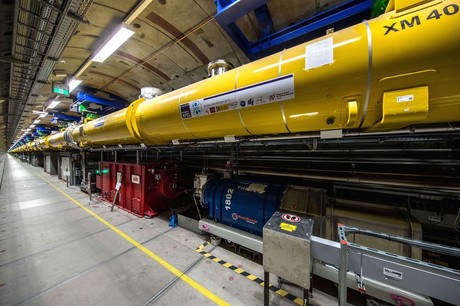World's biggest X-ray laser generates first light

The European XFEL, the biggest X-ray laser in the world, has reached the last major milestone before its official opening in September — the generation of its first X-ray laser light.
The 3.4 km-long European XFEL is the most powerful of the five X-ray lasers worldwide, with the ability to generate the short pulses of hard X-ray light. This X-ray laser light is extremely intense and a billion times brighter than that of conventional synchrotron light sources.
The laser light was generated from an electron beam from a superconducting linear accelerator, the key component of the X-ray laser. German research centre DESY, the largest shareholder of the European XFEL, put the accelerator into operation at the end of April.
In a 2.1 km-long accelerator tunnel, the electron pulses were strongly accelerated and prepared for the later generation of X-ray laser light. At near-light speed and very high energies, the intense electron pulses entered a photon tunnel containing a 210 m-long stretch of X-ray generating devices. Here, 17,290 permanent magnets with alternating poles interacted with the electron pulses from above and below.
The magnetic structures, known as undulators, bring the electrons into a ‘slalom’ course. With every turn they release extremely short-wavelength X-ray radiation, which intensifies across the length of the undulator stretch. For the first lasing, the X-ray light was absorbed and measured shortly before arriving in the underground experiment hall. It had a wavelength of 0.8 nm — about 500 times shorter than that of visible light.

At first lasing, the laser had a repetition rate of one pulse per second. This will later increase to 27,000 per second, instead of the previous maximum of 120 per second. Other features will include extremely high luminosity and the parallel operation of several experiment stations, all of which will enable scientists to investigate more limited samples and perform their experiments more quickly.
The achievable laser light wavelength corresponds to the size of an atom, meaning that the X-rays can be used to make pictures and films of the nanocosmos at atomic resolution — such as of biomolecules, from which better understandings of the basis of illnesses or the development of new therapies could be developed. Other opportunities include research into chemical processes and catalytic techniques; materials research; and the investigation of conditions similar to the interior of planets.
“The first laser light produced today, with the most advanced and most powerful linear accelerator in the world, marks the beginning a new era of research in Europe,” said Helmut Dosch, chairman of the DESY board of directors.
“The European XFEL will provide us with the most detailed images of the molecular structure of new materials and drugs and novel live recordings of biochemical reactions.”
“The facility, to which many countries around the world contributed know-how and components, has passed its first big test with flying colours,” said European XFEL Managing Director Professor Robert Feidenhans’l.
“We can now begin to direct the X-ray flashes with special mirrors through the last tunnel section into the experiment hall, and then step by step start the commissioning of the experiment stations. I very much look forward to the start of international user operation, which is planned for September.”
Revealed: the complex composition of Sydney's beach blobs
Scientists have made significant progress in understanding the composition of the mysterious...
Sensitive gas measurement with a new spectroscopy technique
'Free-form dual-comb spectroscopy' offers a faster, more flexible and more sensitive way...
The chemistry of Sydney's 'tar balls' explained
The arrival of hundreds of tar balls — dark, spherical, sticky blobs formed from weathered...




